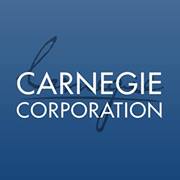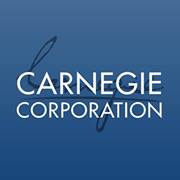Andrew Carnegie founded the Carnegie Corporation of New York in 1911. The earlier nonprofits Carnegie founded, such as the Carnegie Institution of Washington, the Carnegie Hero Fund, and the Carnegie Endowment for International Peace, had narrow, limited aims. But Carnegie, who still had half his fortune when he crated the corporation, left no restrictions on what the Carnegie Corporation should be used for. As a result, the nonprofit gradually deviated from Andrew Carnegie’s beliefs. Before Carnegie’s death in 1919, the Carnegie Corporation eliminated a program created by Carnegie that subsidized the construction of libraries. However, until World War II the Carnegie Corporation largely funded other Carnegie charities.
Under the presidencies of John W. Gardner (1955-1965) and Alan W. Pifer (1965-1982), the Carnegie Corporation dramatically expanded. Its most significant achievement was the Carnegie Commission on Educational Television (1965), which inspired the creation of the Corporation for Public Television. A second commission, the Carnegie Commission on the Future of Public Broadcasting (1979; also known as “Carnegie II”) was far less effective.
During the presidency of Vartan Gregorian (2017-2023), the Carnegie Corporation was awarded substantial grants to left-of-center organizations including the Alliance for Justice, the now-defunct Association of Community Organizations for Reform Now (ACORN) and the Mexican American Legal Defense and Education Fund (MALDEF). It also funded several prizes including the Carnegie Medals for Philanthropy, the Andrew Carnegie Medals for Excellence in Fiction and Nonfiction, and the Andrew Carnegie Fellows, a program similar to the MacArthur Foundation’s fellowship programs but limited to college professors.
In 2023, Dame Louise Richardson became the president of the Carnegie Corporation, a position she holds as of July 2024. 1
Origins
Andrew Carnegie (1835-1919) retired from business in 1901, when he and his partners sold Carnegie Steel to U.S. Steel. He created many organizations with limited aims, including the Carnegie Institution of Washington, which conducts scientific research, the Carnegie Hero Fund2, which gives medals to people who save others’ lives, and the Carnegie Foundation for the Advancement of Teaching, which funds educational research.
By 1906, notes Carnegie biographer Joseph Frazier Wall, “Carnegie was sick of the game” of philanthropy, and by 1910 “he was desperately sick of it.” “The final task dispensation of wealth preparing for the final exit,” Carnegie wrote to a friend, is “a heavy task…all sad.. You have no idea the strain I have been under.”3
When the Carnegie Endowment for International Peace was created in 1910, Carnegie still had half of his fortune. Under the advice of Elihu Root, Secretary of State in the Theodore Roosevelt administration, Carnegie used $125 million to create the Carnegie Corporation of New York in 1911. He imposed only one restriction on the corporation: It would provide pensions for Presidents of the United States and their widows.4
Three years later, Carnegie tried to change his mind. He tried to take $10 million from the Carnegie Corporation budget for a new organization to serve Great Britain. When Root advised that the endowment could not be reversed, Carnegie used money he had saved for his retirement to start the British organization. 5
Carnegie’s wishes were violated a second time during his lifetime when the Carnegie Corporation board voted to slow down and ultimately eliminate the program that funded libraries. Of the 1.419 libraries funded with Carnegie’s money, only six were approved after 1917, two years before Carnegie’s death, with the last opening in American Fork, Utah in 1919. Historian Theodore Jones notes that there is no evidence what Carnegie’s reaction was when the Carnegie Corporation board voted to terminate the library program.6
Eugenics
While the connections between philanthropy and eugenics encompass many groups besides the Carnegie Corporation, one of the most egregious examples lies squarely at the feet of former longtime board member Frederick H. Osborn. 10
After World War II, and the presidencies of John W. Gardner (1955-1965) and Alan Pifer (1965-1982), the foundation dramatically expanded. Under Pifer’s presidency, according to foundation observer Waldemar Nielsen, Carnegie became “the quintessential liberal, activist entrepreneurial foundation, more of a combat force than a traditional charity.”11
Carnegie’s most significant achievement of the 1960s was funding the Carnegie Commission on Educational Television in 1965. The Commission issued a report, Public Television: A Program for Action, which said “we contemplate assistance to Public Television on a far larger scale than at present.”12 All of the commission’s recommendations, including changing the name of educational television to “public television,” creating one quasi-governmental organization to run the stations and oversee content (the Public Broadcasting Service) and a second one (the Corporation for Public Broadcasting) to fund the stations. The only proposal Congress rejected from the commission was a two-percent excise tax on the sale of television sets to pay for shows on public television.
In 1977, the Carnegie Corporation created a second commission to explore ways to fund public broadcasting. Unlike the first Carnegie Commission, the report of the Carnegie Commission on the Future of Public Broadcasting, or “Carnegie II,” issued in 1979, published recommendations that were not implemented, including doubling the size of the public broadcasting budget and paying for it in part by taxing commercial stations’ broadcast licenses.13
In 1985, the Carnegie Corporation met with representatives of other nonprofits Carnegie created to celebrate the 150th anniversary of Andrew Carnegie’s birth. At the event Carnegie Corporation president David Hamburg told the Chronicle of Higher Education that Andrew Carnegie, were he alive, would appreciate “a continuing commitment to three themes that shaped his philanthropy: peace, education, and social justice.”14
The Vartan Gregorian Years
Vartan Gregorian became the Carnegie Corporation’s president in 1997, a position he held until 2023. Prior to becoming Carnegie Corporation president, he was president of Brown University and also served as an adviser to Walter Annenberg in his Annenberg Challenge, a $500 million series of grants to public schools that many consider a major philanthropic mistake. 15 1
The Carnegie Corporation under Gregorian has funded numerous liberal groups. Among others, it has funded the Alliance for Justice, the now-defunct Association of Community Organizations for Reform Now (ACORN), and the Mexican American Legal and Defense Fund (MALDEF).24
Democracy
In January 2024, the Carnegie Corporation listed a series of grants to be sent out for several organizations intended to, “fortify our democracy by strengthening forces of social cohesion and reducing political polarization in American society.” 1 They include several left-of-center advocacy groups and funding collaboratives including the Andrew Carnegie Fellows Program and Press Forward. According to Inside Philanthropy, another recipient, Trust for Civic Life, is a grantmaking collaborative that has received funding from several left-of-center organizations including the Omidyar Network, the Rockefeller Brothers Fund and the David and Lucile Packard Foundation. 25 1
During an interview with Inside Philanthropy in July 2024, Geri Mannion, the managing director of the Carnegie Corporation’s “Strengthening U.S. Democracy” program, mentioned several organizations that had received grants from the Corporation related to protecting voting rights, in particular those “ensuring election integrity” before the 2024 presidential elections. Several groups include United to Protect Democracy, the Campaign Legal Center, the Trusted Elections Fund, the State Infrastructure Fund (SIF), and the Brennan Center for Justice. 1
References
- Scutari, Mike. ““The Election Isn’t the End Point.” A Deep Dive into the Carnegie Corporation’s Democracy Giving.” Inside Philanthropy, July 15, 2024. https://www.insidephilanthropy.com/home/2024/7/15/the-election-isnt-the-end-point-a-deep-dive-into-the-carnegie-corporations-democracy-giving
- For a history of the Carnegie Hero Fund, see Martin Morse Wooster, “Ordinary People, Extraordinary Rescues,” The American Enterprise, November 2000.
- Joseph Frazier Wall, Andrew Carnegie (Pittsburgh: University of Pittsburgh Press, 1989), 881.
- Robert M. Lester, Forty Years of Carnegie Giving (New York: Scribner’s, 1941), 166.
- Burton J. Hendrick, The Life of Andrew Carnegie, Volume II (New York: Harper, 1932), 351.
- Theodore Jones, Carnegie Libraries Across America: A Public Legacy (New York: Preservation Press/Wiley, 1997), 101.
- Schambra, William A. “Philanthropy’s Original Sin.” Hudson Institute. October 1, 2013. https://www.hudson.org/research/9747-philanthropy-s-original-sin.
- Schambra, William A. “How the Carnegie Corporation contributed to NC’s shameful past.” Philanthropy Daily. September 19, 2011. https://www.philanthropydaily.com/how-the-carnegie-corporation-contributed-to-ncs-shameful-past/.
- Krisch, Joshua A. “When Racism Was a Science.” The New York Times. October 13, 2014. https://www.nytimes.com/2014/10/14/science/haunted-files-the-eugenics-record-office-recreates-a-dark-time-in-a-laboratorys-past.html.
- Martin Morse Wooster, The Great Philanthropists and the Problem of ‘Donor Intent,’ third edition (Washington, D.C.: Capital Research Center, 2007). 54.
- Waldemar Nielsen, The Golden Donors: A New Anatomy of the Great Foundations (New York: Dutton, 1985), 134.
- Carnegie Commission on Educational Television, Public Television: A Program for Action (New York: Harper and Row, 1967), 36. The report capitalizes “Public Television” in the text. It is unclear who wrote this report.
- For a discussion of the Carnegie Corporation and public television, see Martin Morse Wooster, Great Philanthropic Mistakes (Washington, D.C.: Hudson Institute, 2010), 125-143.
- Paul Desruisseaux, “What Would Andrew Carnegie Think About How His Money Would Be Used Today?” Chronicle of Higher Education, August 7, 1985.
- For a discussion of Gregorian’s role in the Annenberg Challenge, see Martin Morse Wooster, Great Philanthropic Mistakes, 187-202.
- Kirk MacDonald, “The Carnegie Corporation of New York: From Building Libraries to Undermining American Society,” Foundation Watch, May 2013 https://capitalresearch.org/article/the-carnegie-corporation-of-new-york-from-building-libraries-to-undermining-american-society/
- Celeste Ford, “Announcing the 2017 Carnegie Medal of Philanthropy Recipients,” press release from the Carnegie Corporation, June 22, 2017. https://carnegie.org/news/articles/announcing-the-2017-carnegie-medal-of-philanthropy-recipients/ The Carnegie Medal of Philanthropy website is https://www.medalofphilanthropy.org;
- “Andrew Carnegie Medals for Fiction and Nonfiction,” undated press release issued by the American Library Association http://www.ala.com/awardsgrants/carnegieadult
- Celeste Ford, “Andrew Carnegie Fellows Program Recognizes 35 Scholars,” press release issued by Carnegie Corporation April 26, 2017. https://www.carnegie.org/news/articles/andrew-carnegie-fellows-program-awards-research-fellowships-35-scholars-important-research-social-sciences-and-humanities/
- Celeste Ford, “Academic Leadership Award Recognizes Seven University Presidents,” Carnegie Corporation press release issued September 12, 2017. http://www.carnegie.org/seven-higher-education-visionaires-recognized-2017-academic-leadership-award/
- “In His Own Words: A Q and A With Vartan Gregorian,” http://www.carnegie.org/media/filer_public/58/2d/582d3b2e-50c1-4f77-b1a7-74c9d31d20f/ccny_essay_2010/vgp_t1.pdf
- Leslie Lenkowsky, “The Carnegie Corporation at 100,” Philanthropy, Winter 2011. http://www.philanthropyroundtable.org/topic/donor_intent/the-carnegie-corporation-turns-100/
- “The Centenarians Square Up,” The Economist, June 9, 2011 http://www.economist.com/node/18802844
- Sasha Issenberg. The Victory Lab: The Secret Science of Winning Campaigns. 2012. Pp. 85-86.
- “New Support for State and National Service from Carnegie Corporation of New York.” Carnegie Corporation of New York, January 8, 2024. https://www.carnegie.org/news/articles/new-support-state-and-national-service-carnegie-corporation-new-york/




